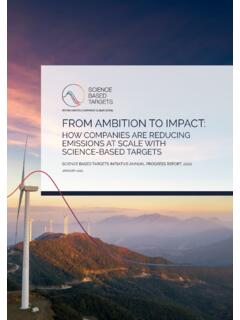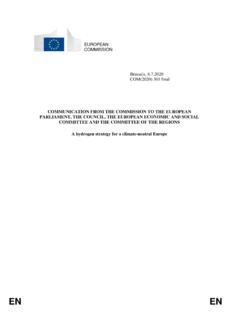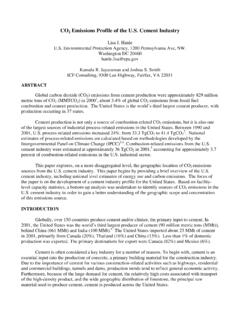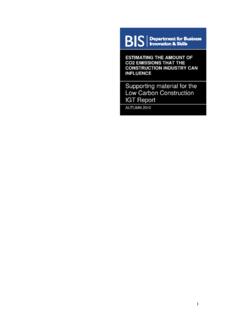Transcription of COMMUNICATION FROM THE COMMISSION TO THE …
1 EUROPEAN. COMMISSION . Brussels, COM(2020) 663 final COMMUNICATION FROM THE COMMISSION TO THE EUROPEAN. PARLIAMENT, THE COUNCIL, THE EUROPEAN ECONOMIC AND SOCIAL. COMMITTEE AND THE COMMITTEE OF THE REGIONS. on an EU strategy to reduce methane emissions EN EN. I. INTRODUCTION. methane is a powerful greenhouse gas, second only to carbon dioxide in its overall contribution to climate change. On a molecular level, methane is more powerful than carbon dioxide. Although it remains for a shorter time in the atmosphere, it has a significant effect on the climate 1 and contributes to tropospheric ozone formation, a potent local air pollutant which itself causes serious health problems 2.
2 Reducing methane emissions therefore contributes to both slowing down climate change as well as improving air quality. Significant portions of methane emissions can be mitigated cost-effectively. The Regulation on the Governance of the Energy Union and Climate Action3 calls on the COMMISSION to deliver a strategic plan for reducing methane emissions . Furthermore, in the European Green Deal COMMUNICATION 4 , the COMMISSION indicated that energy-related methane emissions needed to be addressed as part of the commitment to reach climate neutrality by 2050. In this way, policy action to reduce methane emissions will contribute to both the EU's decarbonisation efforts towards the 2030 Climate Target Plan and the EU's zero-pollution ambition for a toxic-free environment.
3 Current policies for non-CO2 emissions are projected to reduce methane emissions in the EU. by 29% by 2030 compared to 2005 levels 5 . Nevertheless, the 2030 climate target plan's impact assessment 6 found methane will continue to be the EU's dominant non-CO2. greenhouse7. It concluded that stepping up the level of ambition for reductions in greenhouse- gas emissions to at least 55% by 2030 compared to 1990 would also require an accelerated effort to tackle methane emissions , with projections indicating a step up needed to 35% to 37% methane emission reductions by 2030 compared to 2005. At a global level, reducing methane emissions associated with human (anthropogenic) activity by 50% over the next 30.
4 Years could reduce global temperature change by degrees Celsius by 20508. The EU has reduction targets for 2030 for all greenhouse gases, with anthropogenic methane emissions covered by binding national emission reduction targets under the Effort Sharing Regulation (ESR) 9 . However, there is currently no policy dedicated to the reduction of anthropogenic methane emissions . Approximately 41% of global methane emissions come from natural sources (biogenic), like wetlands or wildfires 10 . The remaining 59% are 1. IPCC AR5, (2014). IPCC, 2013: Climate Change 2013: The Physical Science Basis. Contribution of Working Group I to the Fifth Assessment Report of the Intergovernmental Panel on Climate Change.
5 2. European Environment Agency (EEA), (2016). Premature deaths attributable to air pollution (EU 28). deaths-attributable-to-air-pollution. In the EU, premature deaths due to ozone exposure are estimated at between 14,000 and 16,000 per year for the years 2015 to 2017. JRC modelling results estimate that by 2030, depending on levels of methane concentrations, the difference in associated premature deaths would be between 1,800 and 4,000, annually. These results are likely under-estimates as they do not take into account recent re-evaluations of mortality risks associated with long-term ozone exposure, which suggest a factor times higher. 3.
6 (EU) 2018/1999. 4. COM(2019) 640 final. 5. EU 2030 climate target plan Impact Assessment, :749e04bb- 6. EU 2030 climate target plan Impact Assessment, :749e04bb- 7. Significant quantities of non-CO2 greenhouse gases are still being emitted in the EU today, representing around 20% of total emissions . In 2015, methane represented around 60% of total non-CO2 greenhouse gas emission, followed by nitrous oxides and F-gas emissions (EU 2030 climate target plan Impact Assessment). 8. Climate and Clean Air Coalition Scientific Advisory Panel, (2020). 9. Regulation, (EU) 2018/842. 10. International Energy Agency (IEA), World Energy Outlook, (2018), 1.
7 Anthropogenic, of which the largest sources are agriculture (40-53%) in particular linked to intensive production, fossil fuel production and use (19-30%), and waste (20-26%). In the EU, 53% of anthropogenic methane emissions come from agriculture, 26% from waste and 19% from energy11. The reported distribution of emissions per sector continues to evolve as reporting and data collection improve. Nevertheless, these three sectors account for up to 95%. of global anthropogenic methane emissions , and should therefore be the focus of mitigating action12. The EU should also play a role in ensuring methane emission reductions at global level. While the EU contributes only to 5% of global methane emissions13, it can use its position as the largest global importer of fossil fuels and as a strong player in the agriculture sector to support similar action from global partners.
8 The EU is also a technical leader in satellite imagery and methane emission leak detection through the Copernicus program and can lead international collaboration to improve the monitoring and mitigation of global methane emissions . The COMMUNICATION sets out a strategy for reducing methane emissions . It outlines a comprehensive policy framework combining concrete cross-sectoral and sector-specific actions within the EU, as well as promoting similar action internationally. While in the short- term, the strategy encourages global level voluntary and business-led initiatives to immediately close the gap in terms of emissions monitoring verification and reporting, as well as reduce methane emissions in all sectors, it foresees EU level legislative proposals in 2021.
9 To ensure widespread and timely contributions towards the EU decarbonisation objectives. II. A NEW STRATEGY TO REDUCE methane emissions : COMBINING CROSS-SECTOR. AND SECTOR-SPECIFIC ACTIONS. The EU first addressed methane emissions with a strategy adopted in 199614. In the following years, the EU adopted regulatory initiatives that contributed to methane emission reductions in key sectors15. Relative to 1990 levels, energy-sector methane emissions have halved, while emissions from waste and agriculture have fallen by a third and just over a fifth respectively16. Nevertheless, methane emissions remain a significant challenge in each of these sectors.
10 In the energy sector, methane leaks from fossil fuel production sites, transmission systems, ships and distribution systems. methane is also vented (released intentionally) into the atmosphere. Even when flared (burnt), carbon dioxide is released and methane can still escape during flaring as a result of incomplete combustion17. According to current estimates, 54% of 11. European Environment Agency (EEA), (2018). EEA greenhouse gas - data viewer. 12. Climate and Clean Air Coalition (CCAC) Scientific Advisory Panel, (2020). 13. Climate Watch Data, (2016). 14. Strategy paper for reducing methane emissions . COMMUNICATION from the COMMISSION to the Council and to the European Parliament.
















